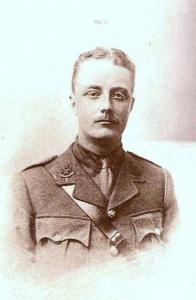
|

|
| Captain Thomas Hugh Corbett WOOLLEY | |
|
B Company, 2/8th Battalion Nottinghamshire and Derbyshire Regiment (Sherwood Foresters) Date of birth: 20th October 1888 Date of death: 27th April 1917 Killed in action aged 28 Buried at Templeux-Le-Guerard British Cemetery Plot I Row C Grave 28 |

|
| Thomas Hugh Corbett Woolley was born at Lincoln on the 20th of October 1888 the eldest son of Reginald Smith Woolley FSA, a surveyor and land agent, and Nora Frances (nee Twentyman) Woolley of 12 Minster Yard, Lincoln. He was christened at St Mary Magdalene’s Church, Lincoln on the 17th of November 1888. He was educated privately at Folkestone and at Lancing College where he was in Heads House from September 1902 to December 1905. He served as a Lance Corporal in the Officer Training Corps. On leaving school he became a Land Agent in his father’s firm, Messrs. Smith Woolley and Wigram of Collingham, Newark-on-Trent in Nottinghamshire. He was commissioned as a 2nd Lieutenant in the 4th Battalion Nottinghamshire and Derbyshire Regiment (Militia) on the 30th of June 1906. He passed the examination for Captain in May 1907 but resigned his commission on the 26th of February 1910 due to ill health. He was married to Violet Joan (nee Tanner) at St Saviour's Church Walton Street in Chelsea on the 11th of September 1913; they lived at "The Cottage", Collingham. They had a daughter, Vera Joan, born on the 15th of November 1916. At the time of his death she was living at 40 Abingdon Road, South Kensington, London W8. Following the outbreak of war he rejoined his old battalion and assisted in training the men at their drill hall at Newark-on-Trent at his own expense. He applied for a commission in the 8th Battalion Nottinghamshire and Derbyshire Regiment on the 26th of October 1914 in an application which was supported by Colonel G.L. Foljambe, former Commanding Officer of the battalion. At a medical examination it was recorded that he was five feet seven inches tall. He was commissioned with the rank of Lieutenant on the 1st of September 1914 and was promoted to Captain on the 5th of November 1914. The battalion was posted to Ireland in April 1915 where they served during the Irish rebellion of Easter 1916. He landed in France at Boulogne with his battalion in February 1917. On the 27th of April 1917 the 2/8th Battalion Sherwood Foresters was ordered to attack a portion of a switch trench at Hargicourt, part of the German defences known as the Hindenburg Line. The night before the attack he met with other officers from the battalion and in the words of the battalion history:- "The officers of three of the companies met together in a cellar to have a final yarn, and it was noticeable that Captain Woolley was the life and soul of the party, happily discussing what he would do when the war was over in company with his wife and child, to whom he was devoted. Alas! He was the only one amongst those gathered there to make the supreme sacrifice". During the attack Thomas Woolley, at the head a platoon from B Company, was the first into the enemy switch trench but was killed immediately. The enemy counterattacked driving the men of B Company back and out of the position but it was later recaptured and his body was recovered. His Commanding Officer, Lieutenant Colonel W Coape Oates, wrote:- "He was gallantly leading his Company in action when he fell, just doing (as he always did) a little more hard work and a little more courageous work than his body would stand. What his Company will do without him I do not know, as his whole life was wrapped up in their welfare. I shall miss him terribly." The battalion history stated:- "The death of Captain Woolley was deeply felt throughout the Battalion. Captain Woolley's name was almost a household name in the 2/8th Battalion, and in the old 4th Notts; which preceded it, as three generations of that family had commanded one of the companies. Captain Woolley was an officer of exceptional ability and boundless energy, his pluck and vitality making up to some extent for a rather frail body and indifferent health" He was buried with military honours on the 29th of April along with others from his Company who had fallen. He was mentioned in despatches which was announced in the London Gazette of the 21st December 1917 for "gallant and distinguished service in the field". His widow applied for his medals in March 1921. His original grave marker rests at the Church of St John the Baptist in South Collingham. |
|
| Heads House |
Back